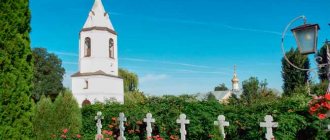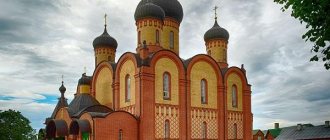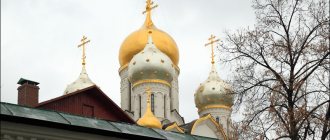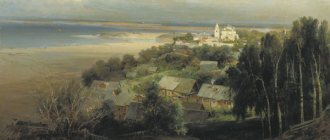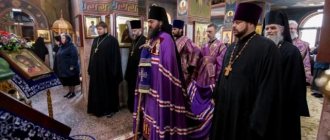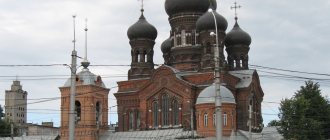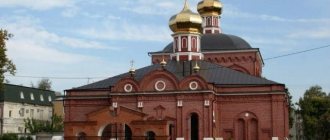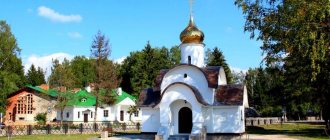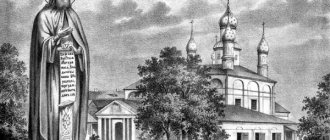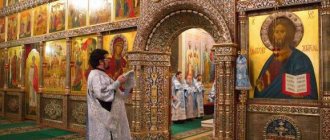The Paraskeva-Voznesensky Convent is an architectural monument of the 18th century. It is located in a cozy place in the village of Paygarma. This shrine has a reviving status. The monastery was built in honor of the holy martyr Paraskeva. An unusual phenomenon once happened at this place. I saw an icon of a martyr in 1865. Today the shrine serves as the main shrine of the complex. It was written in the 19th century, on Mount Athos. In the process of its creation, particles of the saint's relics were used. God's servant is distinguished by special grace. She helps arrange family life.
The image is also considered the patron of trade. Not far from the monastery, three springs formed - Paraskeva Pyatnitsa with a font, St. Nicholas the Wonderworker, Seraphim of Sarov (mineral spring). Women suffering from infertility often turn to the key of St. Paraskeva. Here they receive special care for infertility and vision treatment. There are many lakes and forests nearby. The village is picturesque.
The Ascension Monastery was the third in the number of monasteries built in Moscow
The Ascension Monastery of the Moscow Kremlin was the third monastery in Moscow. The very first church of the monastery was wooden - the Cathedral of the Ascension of the Lord. As you know, it was founded by Evdokia Dmitrievna and built at the Spassky Gate.
Unfortunately, there is no portrait of Princess Evdokia, but there is a sculptural reconstruction made from the princess’s skull. This is the only way we can guess what she was like. According to her instructions, they began to build a monastery
Unfortunately, there is no exact date for the construction of the monastery, but according to the supposed version, this happened after the death of Dmitry Donskoy himself in 1386.
Near the place where they were going to build the temple, there was the palace of Dmitry Donskoy and the tower of Evdokia.
1407
this year the Grand Duchess widow Evdokia took monastic vows with the name Euphrosyne
In 1407, the widowed Grand Duchess Evdokia took monastic vows with the name Euphrosyne. By this time, the temple was already standing, and the grand ducal mansions were occupied by cells.
But in the same year, Evdokia ordered the foundation of a new stone Church of the Ascension. She lived as a monk for only a few weeks, after which she died and was buried in a new church under construction.
As the legend says, candles began to light up at her coffin and people were even healed. After Evdokia became the patroness of Moscow, she was even named Venerable Euphrosyne of Moscow.
The construction of the cathedral was continued by another princess, Sofya Vitovtovna. She was the wife of Vasily the First. The monastery took a very long time to build due to constant fires in Moscow. Unfortunately, the monastery was never completed.
In 1467, Princess Maria Yaroslavna, the widow of Prince Vasily II, ordered the temple to be dismantled and a new one built in its place.
The construction of the temple was entrusted to the Moscow merchant Vasily Ermolin. He preserved the building, but at the same time rebuilt the vaults and lined the walls with new bricks.
An accurate description of the temple itself has not survived to this day. But according to the supposed version, the temple was made of white stone with carved facade decoration.
The stone Ascension Cathedral was consecrated in honor of the Ascension of the Lord in 1468 by Metropolitan Philip of Moscow. The temple became a tomb for the Moscow queens.
The nuns of the monastery were engaged in needlework, and also sewed towels and lace.
The temple constantly suffered from fires, and in 1518 Vasily III began again the construction of a new stone cathedral.
Vasily III - Grand Duke of Vladimir and Moscow, sovereign of all Rus'. It was he who decided in 1518 to build a new stone Church of the Ascension
It was built on an existing foundation by Aleviz Fryazin, who by that time had already completed the construction of 11 churches.
1527
this year St. George's Church was built from the Ascension Cathedral
In 1527, the St. George Church was built from the Ascension Cathedral. The church was single-domed with three apses. But at the end of the 16th century, by order of Tsar Fyodor Ioannovich, the cathedral was again dismantled due to its dilapidated condition.
The next one was built in the form of the Archangel Cathedral, which was built under Tsar Feodor. The monastery was decorated with new icons.
The photo shows the monastery after it was built in resemblance to the Archangel Cathedral by Vasily III
In 1613, Mikhail Fedorovich settled his mother, nun Martha, in the cathedral. She lived in her cell for 18 years. The coat of arms of the Russian kingdom was installed above the cell.
The monastery in the Moscow Kremlin became very famous; even the royal family paid special attention to the monastery. Kings and queens visited the tomb very often.
Architectural lighting
Architectural lighting of the Ascension Cathedral On September 10, 2005, in the city of Novocherkassk, the architectural and artistic lighting of the Military Ascension Cathedral was switched on.
The project provides for the use of lamps that create narrowly directed beams of light, as well as floodlights. Thanks to the use of flood light in the project, specialists achieve the transfer of the overall volumetric-spatial form of the architectural structure. Narrowly directed beams of light allow you to highlight decorative elements. The lamps installed in the five belfries will create the effect of a “lamp” - glowing from the inside. What makes this object unique is the projection on the façade of the cathedral, made using equipment from the Austrian company Pani. The automated slide changing module is designed for 32 pictures.
Projections on biblical themes, as well as the use of works by masters of Flemish painting (Paul Rubens' Ascension of Christ) create the impression of a divine presence. The inclusion of images is carried out on Christian holidays. Another feature of this equipment is that the projector can be installed at an angle to the surface on which it is projected. The projector power is 6 kW, which gives a fairly bright image even in the twilight period. A special optical correction system corrects keystone distortion, and the condenser lens system provides a clear and large image.
You can verify the uniqueness and splendor of the Ascension Cathedral by watching the proposed video.
Under Mikhail Fedorovich, the Church of Mikhail Malein was built
Under Mikhail Fedorovich, the wooden church of Mikhail Malein was also built.
In the photo from the end of the 19th century you can see under the number 1 - the Ascension Monastery, 2 - the Catherine Church, and under the number 3 - the Temple of Mikhail Malein
It was rebuilt into a two-tier stone church with a chapel of Theodore of Perga. A church was built on the top floor, and two cells were located on the bottom floor.
On the western side of the church there was a refectory, above which rose a bell tower with 9 bells.
At the end of the 17th century, the monastery owned 2,128 households. And the annual monthly income received from the monastery was 3,270 rubles.
The monastery also owned estates and courtyards in different counties. The sacristy of the monastery contained royal gifts, as well as the golden cross of Tsar Mikhail Fedorovich and the golden vessels of Alexei Mikhailovich.
Alexei Mikhailovich is the second Russian Tsar from the Romanov dynasty. He was the son of Mikhail Fedorovich and his second wife Evdokia. Golden vessels from him were kept in the sacristy of the monastery
In 1724, new cells were erected and the old ones were repaired. In 1729, the cathedral began to be covered with iron.
Soon, in 1730, it was decided to make two chapels in the Ascension Cathedral. One is Uspensky, the second is in the name of the icon “Joy of All Who Sorrow.”
Exactly seven years later, the monastery was badly damaged in a fire, as a result of which the Church of Mikhail Malein and the bell tower adjacent to it burned out.
One of the schema-nuns prayed to the Mother of God in front of the icon, which was located at the tomb of her father. Then, miraculously, the icon ended up in the monastery. It was discovered only after the fire.
The restoration work was carried out by the then famous architect Ivan Michurin.
Places of power
There are a large number of cases in history when people suffering from various diseases recovered by bathing in local springs. So, in 1998, a few days before the start of Great Lent, a miraculous phenomenon occurred in the monastery. The well-known icon “Blessed Heaven” began to bleed myrrh. This phenomenon was seen by parishioners who were present at the service at that time. Myrrh flowed from the icon. This is the name for fragrant church oil. All those present at the service were anointed with myrrh.
In addition, after a certain period of time it became known that one of the parishioners was able to recover from an illness that had tormented him for years. It was a young man named Pavel Zhuvaikin. He was 12 years old. From birth the child was blind in his left eye. After the anointing, the boy received his sight. Throughout the history of its existence, the icon streamed myrrh three times - on February 27, March 1 and 8.
Paraskev-Voznesensky Convent is located 35 kilometers from Saransk. There is a large railway station not far from the shrine. The date of foundation is 1864. This was an initiative of local residents. The popularity of local sources is great. People come to them from various regions. Local water is used for washing, part of the water is used for the bath, and part is discharged into the drain, which is located under the altar.
During the October Revolution, the walls and domes of churches were destroyed
In the fall of 1917, during the October Revolution, the walls and domes of the churches were destroyed.
Members of the sacred cathedral, after the shelling of the monastery, wrote about the destruction:
“First of all, on the way we stopped at the Ascension Convent for women.
There was already complete destruction here.
In the Church of St. Catherine the Great Martyr, the wall of the upper cornice and the upper arch of the temple were pierced through by an artillery shell.”
The nuns were ordered to leave the monastery and settle temporarily in the church of the Lefortovo hospital.
Some of the icons and jewelry were secretly removed from the monastery and hidden in the courtyard.
The valuables were still found and sent to the Armory.
Some valuables were transferred to the Cathedral of the Twelve Apostles.
The cells of the monastery began to be used as a dormitory, in which Kremlin service personnel lived. A gymnasium was built in the church in the name of St. Catherine.
In 1918, a special Kremlin commission was established to preserve Kremlin buildings. Its leaders were architects Ivan Rylsky and I. I. Dumoulin.
In the Ascension Monastery, it was decided to repair all the damage, as well as update the domes and plaster.
But, unfortunately, there was not enough funding for this project. Therefore, the plan did not come true at all.
Only those places that were heavily damaged by shelling were restored.
In December 1918, one of the church valuables was removed from the monastery - the icon of the Church of Our Lady Hodegetria.
It was first transferred to the Peace Chamber of the Patriarchal Palace, then sent to the State Historical Museum and the State Tretyakov Gallery.
Icon of the Mother of God “Hodegetria” from the first quarter of the 15th century. It was she who was saved during the shelling of the Ascension Monastery. She was rescued and in the end remained in the Tretyakov Gallery
In 1920, work to support and preserve the Kremlin buildings was restored.
Gradually, the condition of the building began to deteriorate, the soil in the monastery completely subsided and the walls of the buildings completely collapsed. But no restoration work was carried out.
Soon, at various meetings, questions were raised about the demolition of the monastery and the construction of a military school there.
Many were against this, but in 1929 the monastery was blown up. The sarcophagi with the remains from the tomb were transferred to the Archangel Cathedral. 4 icons were also rescued and taken away.
1929
this year the monastery was blown up, replaced by a military school
Unfortunately, during the demolition of the monastery, they were unable to establish the measurements according to which the temple was built.
A military school building was built on the site of the destroyed temple.
History of construction
The first bishops who appeared in Turkestan at the end of the 19th century began to think about the need to build an Orthodox cathedral in the city of Verny. There was long-term correspondence on this issue, and even the first projects and estimates were drawn up, but their implementation began only at the beginning of the last century.
The foundation stone for the cathedral took place at the end of September 1903. It was built during 1904-1907. The project engineer was A.P. Zenkov, and the author was the architect K.A. Borisoglebsky. This building is unique in that for the first time in Semirechye during construction, antiseptics for wood, reinforced concrete structures, supply and exhaust ventilation systems, etc. were used during construction. But the most important thing is that for the first time Semirechye builders erected such a high-rise building, at the same time solving the most important issues related to the seismic stability of a structure.
Although people say that the cathedral was built “without a single nail,” it is known that metal parts were still used to connect the structures. In the walls and in the corners, the log houses are fastened with wooden beams, fastened with bolts. All rafters have metal brackets and ties, etc.
In the 90s of the 20th century, work began to study the tombs of grand duchesses and queens
In the 1990s, work began on studying the tombs of the grand duchesses and queens.
As it became known, the first wife of Peter I, Sophia Paleologus, the wife of the Russian Prince Ivan III, as well as Princess Theodosia, the daughter of Tsar Mikhail Fedorovich, were buried in them. The wife of Vasily Shuisky is also buried.
2004
this year, burials were examined in the underground chamber next to the Archangel Cathedral
32 graves were examined, as a result of which data was obtained on the appearance of the buried and on the burial ritual. The clothes and shoes that were found in those sarcophagi were restored.
The photo shows the very tombs next to the Archangel Cathedral, according to which the clothes and shoes of the people of that time were created
In 2014, President Vladimir Putin proposed recreating the historical appearance of the Moscow Kremlin and restoring the Ascension Monastery.
UNESCO experts opposed this construction.
In May 2022, the director of the Moscow Kremlin Museum firmly stated that no construction was planned. In 2016, the 14th building of the Kremlin was dismantled, and archaeological excavations were carried out at this site.
In May 2016, a square was laid out, and in the summer an exhibition dedicated to the Ascension Monastery was held in the Archangel Cathedral.
In December 2016, archaeological windows with found parts of the foundation of the Ascension Monastery appeared on Ivanovskaya Square.
Unfortunately, not one of the temples that once stood was restored. And we can observe the beauty of these monasteries and temples only from the pages of history.
This is what we can now see instead of that Ascension Monastery and the churches closest to it. 2022
Perhaps none of those passing by these places even thought that the famous third monastery in Moscow used to stand on this site.
By leaving a comment, you accept the user agreement
